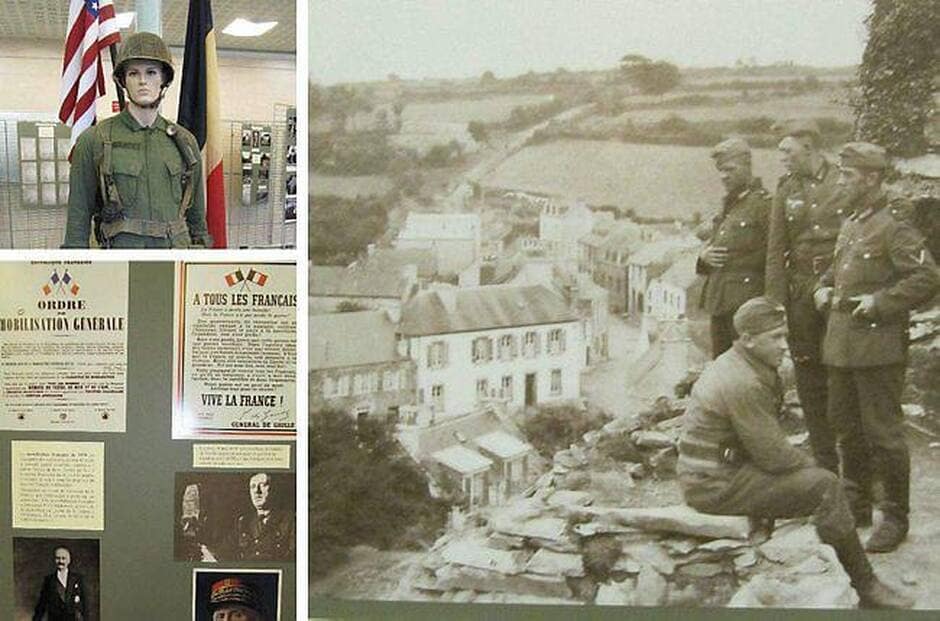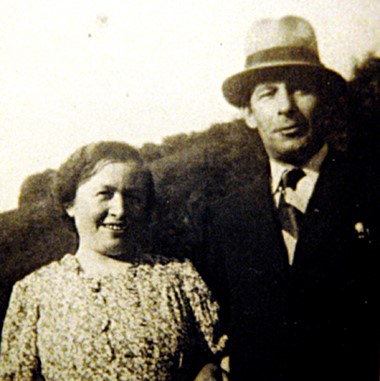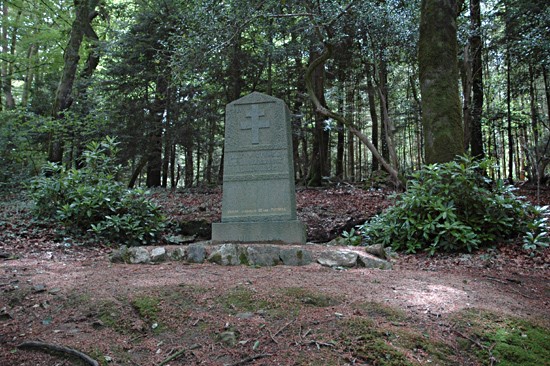The sad wartime history of La Roche Maurice is echoed throughout France.

WW2 Photographs and Memorabilia (Ouest- France)
1940 The Pointois Wood
Close to the major port of Brest, La Roche-Maurice suffered German occupation from the 19th June 1940.
Near this village lies a large manor house with grounds including woods known as the Pointois Wood. During the occupation of France this house and grounds were requisitioned by the Germans. Barracks were installed and many people came to be based here.
The Pointois wood sheltered 2 Nazi camps. To the east, a resting camp for the Kriegsmarine sailors whose battleships were based periodically at Brest and to the west an accommodation camp for 700 to 800 Dutch and Belgian workers from the Todt organisation , who worked on the construction of the Atlantic Wall which was designed to be a strong coastal fortification to prevent any invasion from Britain and its allies. The workers would leave by buses every morning to get to their place of work (the buses were parked on the land which became the new pedestrian way which follows the route of the Duc DAigullon on the left heading towards Landernau)
Civilians from Brest who had found refuge at La Roche . of which 2 Jewish families Menner and Haas ) Menner being the in laws family of Pierre Le Bris , future librarian and editor in Brest)…
…without forgetting the owners of the land and Manor house itself.
One could say that there were more people in the Pointois wood than in the community of La Roche itself.
1942 The Round-up of the 10th October
On the 7th October the SS SS Sturmbannführer und Kommandeur, Dr. Heerdt gave out a general instruction to the Police Superintendent of the Rennes Prefecture district.
“On the 9th October 1942 the Jews mentioned on the following lists must be arrested by the police services placed under your orders and delivered before the 10th October or later to the camp situated on the Champ de Mars. Over and above the persons indicated below on the list you are at liberty to arrest all members of their family regardless of age and sex including children and to deliver them to the same camp.”
The Finistère region had few Jews : 123 in total , 83 in the suburbs of Brest, of which 20 were tradespeople.
A Jewish couple were arrested by the Police in Landernau at La Roche Maurice on the 10th October 1942. They were sent to Auschwitz and never returned.

Local Jewish couple deported 10th October to Auschwitz.
The Police station at Landernau was advised by telephone on the 9th October 1942 at 6 o’clock in the evening that they had to arrest the Menner family. The parents and their daughter Blima Le Bris had left their house in Brest to shelter in La Roche Maurice. The policeman carried out the order the following morning at 5h 25. They had the evening and the night to warn their victims. Nobody wanted to do this and the mission proved to be more hectic than expected.
“Having been assured that the order of which we were the carriers applied to Madame Blima we invited her to start packing. We also went to her parents who were residing in a neighbouring room. Mme le Bris made use of this time to escape with her husband into the Pontois wood. By reason of the dark we could not locate her there. We drove M et Mme Menner to our police station at Landernau. At 8 o’clock resuming our searchers in the Pointois wood we discovered M Le Bris concealed under some tree branches. This man informed us that his wife had taken the 734 train from La Roche Maurice station to go to Brest to her parents in law at 41 rue Jean Mace. Of course the information was false allowing the fugitive to earn a little more time. Le Bris Blima nee Menner was not discovered in Brest. She was at large and wanted.”
In Paris, where the couple finally found refuge, the Le Bris couple evaded a second attempted arrest in 1943. This information is recorded in December 1944 in a report from RG to the sub prefect in Brest who was called to agree the naturalisation request presented by Blima Le Bris. The conclusion of the police enquiry was favourable but the reason given a few months after the Liberation in order to recognise French citizens was quite disturbing. “Nothing should oppose her acquiring French citizenship. She must however renounce her Jewish religion and become Catholic”
Nevertheless the flight of this young woman from La Roche-Maurice, Blima Le Bris, was considered very annoying to the Germans. Without her, given that Jacob Krouto was already detained and Ita Apolojg had already left Brest, with his two daughters in July, the success of the operation would have been total, perfectly illustrating the wish of Pierre Laval and the close collaboration between the French and German police. (source Toczé & Lambert)
1944 The Pontois Massacre

Monument to the Massacre at Pointois Wood
Within the Pointois wood there lies a sombre monument which harmonises with the natural surroundings due to the skill of M Maze, the marble sculptor of La Roche Maurice.
On the monument are engraved from top to bottom , the cross of Lorraine with the initials in the corner H.P. ( Honour and Patrie (Country)) and the dedication “To the victims of Nazi barbarism” and the names of the victims.
Roger Bras, historian of La Roche-Maurice, reminds us of the events in the following extract
“After the landings of the 6th June 1944 the Germans in the woods headed towards the east and with anger in their hearts the Nazis carried out multiple massacres. Harassed by the Resistance network under the control of Lieutenant Noyon of Douarnenez, soldiers of a division of the German parachute regiment belonging to the Army Corp, under the command of General Ramke, captured on the 25th July 1944 a dozen resistant fighters led by Thomas le Moan of Ploare.
Later, the sergeant Herwin Fritz publicly boasted of having punished terrorists during the night between the 30th July and the 1st August. Informed by a German soldier of the Wehrmacht, the inhabitants of La Roche Maurice discovered the bodies after the departure of the German parachutists on the 10th August. Here perished these victims of Nazi barbarism.“
LE MOAN Thomas – Aspirant F.F.I. born 17.10.1914 in Ploaré, 30 years.
BOULIC Joseph – Sergeant F.F.I. born 19.03.1922 in Kerlaz, 22 years.
BROUQUEL Joseph, born 21.12.1918 in Kerlaz, 26 years.
STRULLU Alain, born 16.07.1916 in Kerlaz, 28 years.
GUEGUEN Henri, born 16.02.1915 in Ploaré, 29 years.
LUCAS Pierre, born 29.05.1925 in Ploaré, 19 years.
Further to these 6 resistant fighters, Jean Francois Queau, agricultural worker, was shot for not having wanted to hand over his work cart. He was native to Pleyber Christ. His name was added later to the monument.
The Resistance Fighters in the Pontois Wood
Here as an extra witness account reported by Roger Bras and written by Joseph Abiven who was a farmer and owner of the Pontois wood who transported the bodies of the six to the communal cemetery.
“I was witness to these facts at the end of July 1944 when a German soldier had announced to us that there was a cemetery of terrorists in the Pontois wood. As soon as they retreated to Brest at the beginning of August we searched: the Germans had dug about 20 casemates all covered with tree trunks. However one casemate had been backfilled. There we found the bodies of 6 patriots, 3 from the village of Kerlaz , 3 from Ploare near to Dournanez, piled one on top of the other on the exact space where now is their monument.
They were dressed in work clothes and the date of their death was, we believe, 31st July. Were they killed in the wood itself? Certain residents from La Roche believed they heard them cry out.
The exhumation of their bodies took place 6 or 7 days after their death. I transported them by horse cart wrapped up in tarpaulins to the cemetery for a temporary burial near to the monuments for the dead. The inhabitants of La Roche Maurice assembled around to welcome the cortege whilst the tricolor flag flew on the old castle.
The newspapers ceased to appear from the moment of the German invasion so it was necessary to wait for their reappearance a few days after before a communication could be sent out inviting the families to come and identify the bodies. Some parts of their clothes had been removed from each one, we saw no mutilation on their bodies, no torn eyes or bullet marks. But all had their hands tied behind their backs with wire.
They all had belonged to a resistance network and one of them had, it seems, close links with an Alsacien mobilised in the Wermacht. He had denounced them. They were all carrying a half 5 franc note which was proof of their belonging to the Resistant network.
Two months after the departure of the Germans, an old person collecting dead wood from Pontois had the unfortunate surprise of finding in a trench a 7th body. This person, an agricultural worker from Pleyber Christ aged 62 years had been requisitioned with his cart to assist moving the troops towards Brest. This man was killed by a bullet in the head.”
1948 Inauguration of the Monument
The monument was inaugurated on the 7th April 1948 in the presence of various delegations representing the former resistance organisations: from the mayor of La Roche, M Coat: the priest of the La Roche, M Cam and several other personages from the Finistere region. Lieutenant Noyon, head of the Maquis of Dournanez read out the names of the patriots inscribed on the monument . Captain Lambert posthumously awarded the Order of the Brigade to all those victims and pinned on the chests of their parents, who were standing in front of the memorial, the Croix de Guerre.
See also:
Twinning – La Roche Maurice and La Roche Maurice in World War Two
